Guyana

An aerial photo over the Kanuku Mountains Protected Area, Guyana. © Daniel Rosengren
In February 2017, I was sent on a photographic assignment to Guyana by the Frankfurt Zoological Society (FZS). FZS is a conservation organisation that I like working for. Partly because I like the way they work, long-time commitments protecting large and biodiverse areas, and partly just because their project areas are pretty amazing.
I knew it was coming, but still I wasn’t ready for the sight that suddenly appeared under my shoelaces
Before going on a trip to a place I have never been, I often go through books to see what animals I have a chance to see. Guyana certainly had a lot of spectacular species to offer, beautiful ones, impressive ones, and weird ones. But, I didn’t want to get my hopes up too high. I know that though the rainforest has a high species diversity, it is also very good at hiding them and most species usually remain unseen. You can’t see all the animals because of the forest, so to speak.
Already on the way from the airport to the centre of the capital, Georgetown, I spotted something extremely red far away against dark blue clouds. It was the Scarlet ibis, an unmistakeable bird, as red as physically possible. That was already one of the beautiful species I had hoped to see.
My first task in Guyana was to document illegal gold mining inside the Kaieteur National Park. This was a mission run by the FZS governmental partner in Guyana, PAC (Protected Areas Commission). I was placed facing backwards in a four seat Cessna plane with the door removed (so I could take photos better). That Guyana is one of the least populated countries in the world soon became quite clear. Not long after leaving Georgetown, we were flying over seemingly endless rainforest canopy, with no or very little signs of human presence. Guyana has a population of about 736,000 people on a surface roughly the same as that of the United Kingdom, giving Guyana a population density of only 3.5 people per square kilometre. The density in Germany is 271 people per square kilometre, 77 times higher.
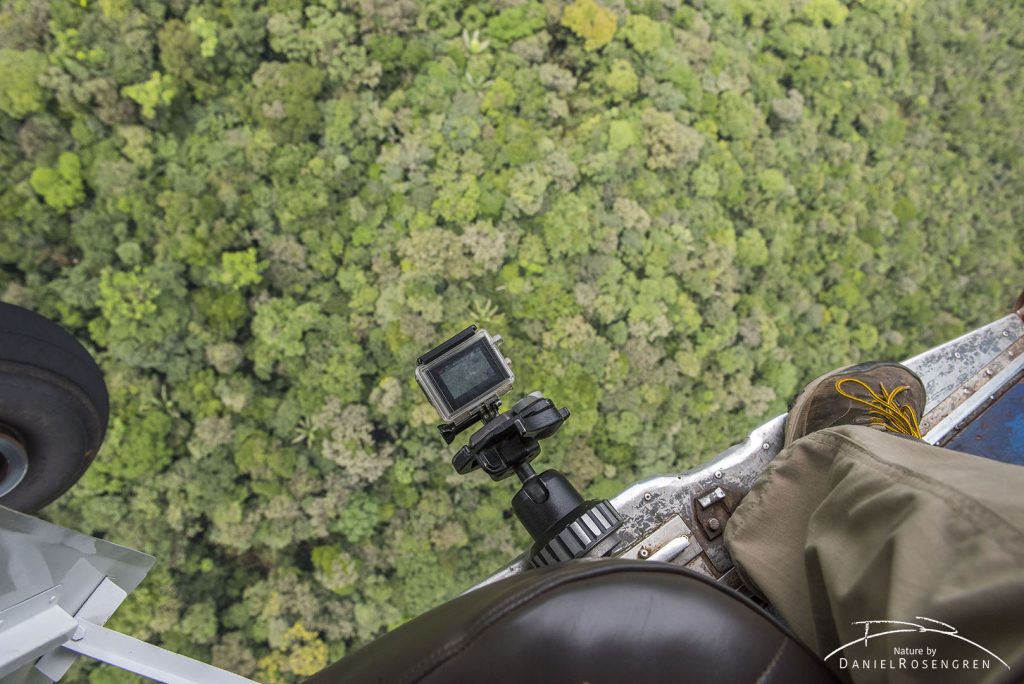
My view out of the plane, the best window seat ever. © Daniel Rosengren
My shoelaces were flapping about in the wind as my foot was halfway outside the plane, the interior of the plane was kept together with transparent tape and my seatbelt slowly loosened itself. Every now and then I had to tighten it again. After about an hour and 15 minutes I was suddenly surprised with awe. I knew it was coming, but still I wasn’t ready for the sight that suddenly appeared under my shoelaces. Right below me were the Kaieteur Falls, one of the most impressive waterfalls in the world, in fact, there is no waterfall that high, with the same amount or more water in it. 226 meters high, it is almost five times the height of Niagara Falls and more than twice the height of Victoria Falls. And the setting is stunning, the water runs off a huge cliff in dense rainforest. On the sides of the water curtain, you can see into a huge dark cave behind the falls, it is still unexplored.
Flying straight above these falls was truly breath-taking. Once inside the national park we did find some illegal gold miners, luckily still on a small scale. The advantage with working with conservation in Guyana is that the human population is still small and threats are therefore relatively small and usually on small scale. It is better to act before it gets worse, if action is taken now, great conservational successes can be achieved relatively easy and with relatively small means. The gold mining technique used in South America and other places too, is by dredging. This is a particularly bad method as forest and rivers are not only physically destroyed, but they are also poisoned by the mercury used in the process. This mercury is very dangerous not only to nature, but to all humans living downstream the rivers. Children and unborn babies are particularly vulnerable.
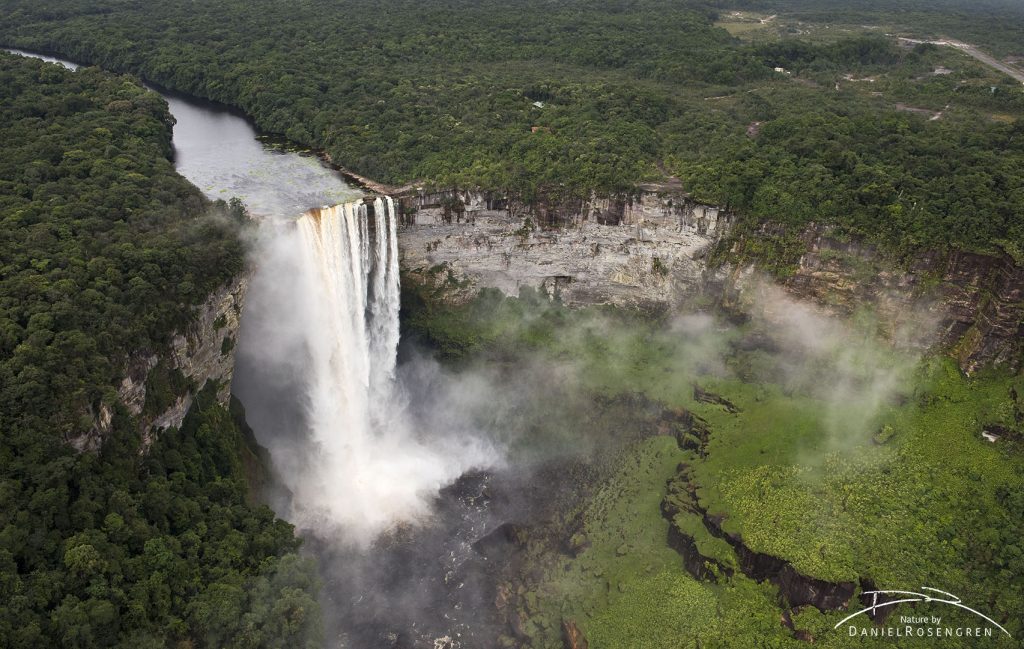
Kaieteur Falls, 226 meters high. No waterfall in the world with that amount of water is higher. © Daniel Rosengren
A few days later I was on a boat together with FZS project leader Thadaigh Bagallay, a few PAC rangers and expedition organizer Ashley Holland and his team (Rupununi River Drifters). We were going into the Kanuku Mountains Protected area. It is a basically untouched rainforest area with small mountains, surrounded by a dry savannah landscape. I was told that the areas have some of the highest bat and fish species numbers in the world. The latter is not difficult to believe as ospreys are very common there and they are often seen with a freshly caught fish in their claws.
After about half a day travelling up the sand coloured Rupununi River we turned onto a much smaller black-water tributary, Maparri Creek. Where the clear Maparri Waters met the Rupununi the different coloured waters mixed in beautiful whirlpools. The Maparri was very low on water and we often had to go out and push the boat over shallow waters or narrow passages or under fallen trees. In the late afternoon, we arrived at the campsite, beautifully located next to some rapids on the Maparri Creek.
We spent the next four days exploring the area, both day and night, mostly from the boat as there were very few trails around. The rainforest was very generous and showed me many of the animals that I had wished for, but not dared hoping for. The majestic Harpy eagle was sitting in a huge Ceiba tree. Being the most powerful eagle in the world, the Harpy was definitely among the impressive animals I wanted to see and take photos of, but it is also a very beautiful eagle. Some of the other impressive species we saw were the Goliath birdeater tarantula (the world’s largest spider), a group of Giant otters (the world’s longest otter) swam across the river in front of us, and, three different species of caimans (the Black caiman being among the biggest crocodilians in the world).
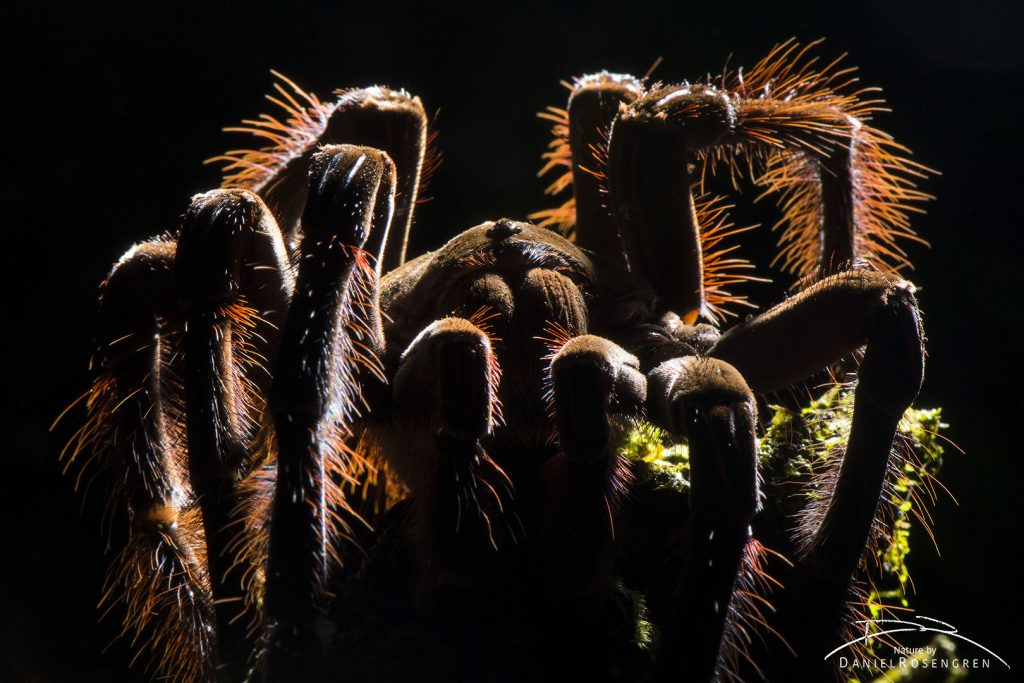
The Goliath Birdeater is the world's largest spider. © Daniel Rosengren
Among the beautiful species we saw were several hummingbirds with sparkling metal colours (including the Crimson topaz), colourful parrots and macaws, the Venezuelan suntiger (a beautifully coloured tarantula that was only first discovered in 1994), and, the Glass frog (a small semi-transparent frog, bright green with yellow eyes).
There were a great number of species that fall under the category of weird animals. For example, the White bell bird (a small, pure white bird with a very long wattle and a very strange and loud call, it sounds like an electronic alarm and carries several kilometres), the Guianan Cock-of-the-Rock (a weird looking bird that is as orange as orange can be). An even weirder bird with a weirder sound was the Capuchinbird (a fluffy brown bird that appears to have grown bald on its head, exposing its blue skin and somehow sounding like a distant engine, grrrrWaaaaaaoooo!).
At night, we saw a swimming Tapir (the largest land mammal of the continent with a trunk that makes it fit well into the weird animal category). We also found a Three-toed sloth with a little baby high up in the canopy (these are truly cute animals, but also weird with their slow-motion life and algae growing in their fur). The guide, Ashley, was very excited when we found two Zigzag herons, these rare and extremely difficult to find birds are small herons where the head seems to make up a third of the total bird size, their plumage looks like granite and their eyes are black with a tiny yellow ring in it.

Red-and-green Macaws in Kanuku Mountains Protected Area. © Daniel Rosengren
Guyana and the Kanuku Mountains greatly exceeded my expectations, it’s a paradise for a wildlife photographer as well as naturalists. To see all these fantastic animals in such a short time really shows what a great area this is. In fact, Ashley told us that because of the unusually low water levels for the season, we couldn’t even get to the really good areas of the Kanuku Mountains. The very last night in the area, I was walking along the rapid waters of the Maparri, shining down in slower running pools with my torch. And there, I found an animal that I hadn’t ever expected to see in my whole life, actually, I had never even contemplated it as a possibility. But there it was, an electric eel! It’s looks are prehistoric and the fact that they can generate electrical discharges of up to 860 Volts to stun prey and fend of threats makes me truly in awe for nature and evolution. Let’s make sure this area remains like this forever.
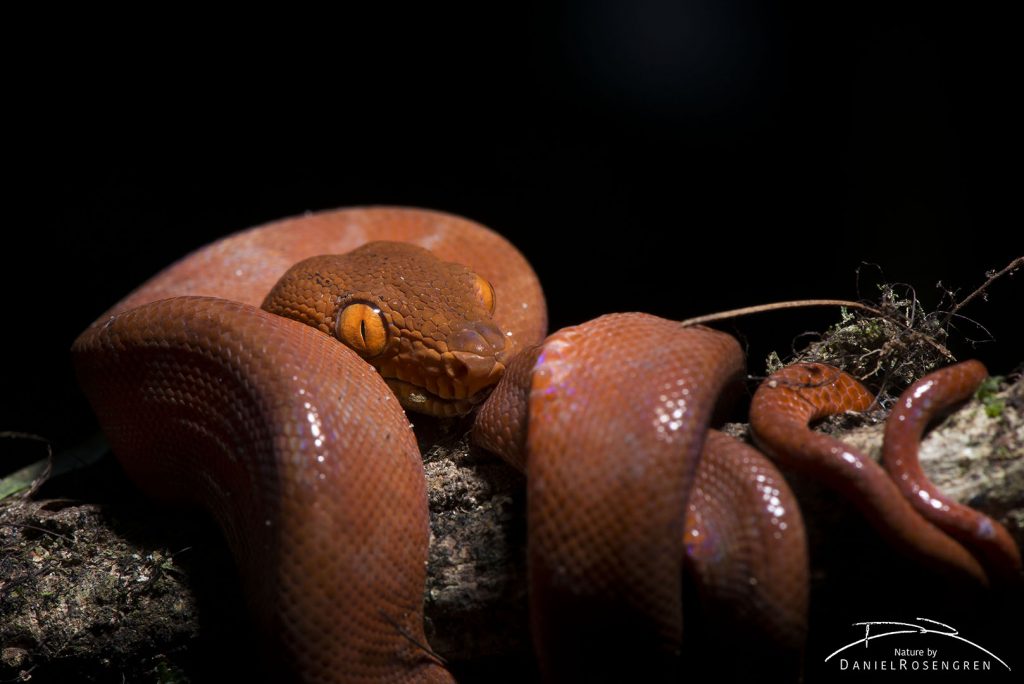
An Amazonian Tree-Boa. © Daniel Rosengren
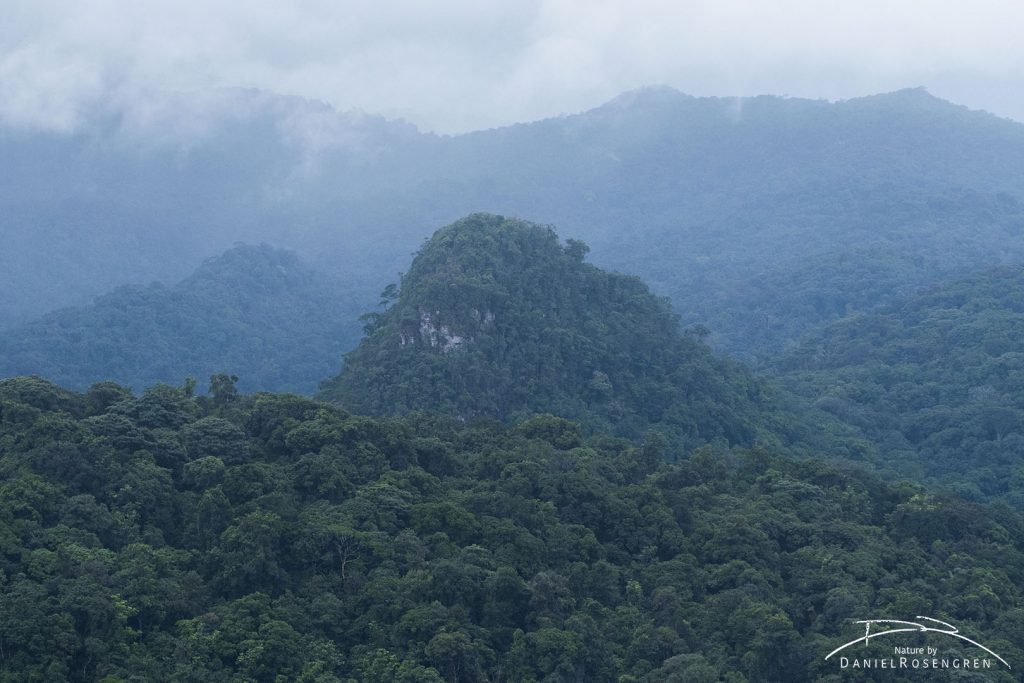
An aerial photo of the rainforest in Kaieteur NP. © Daniel Rosengren

A mother Pale-throated Sloth with a baby looking into the camera. © Daniel Rosengren
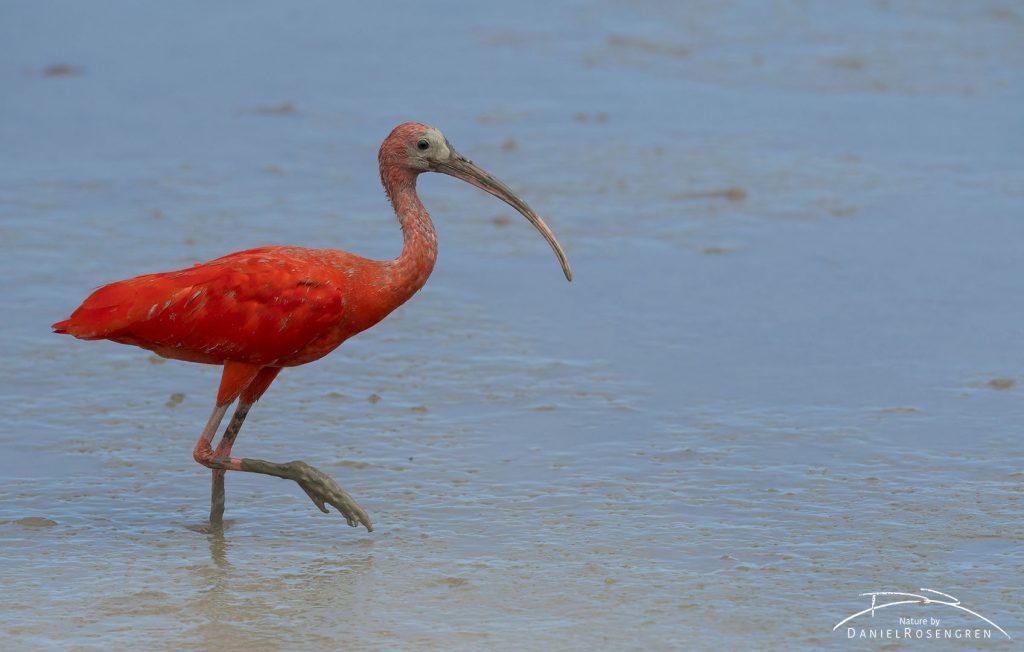
A Scarlet Ibis on the coast of Georgetown, Guyana. © Daniel Rosengren
See more photos in the Guyana Gallery.
